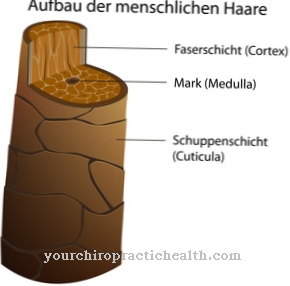A Inflammation of the bones is an infection with often very malicious microorganisms. Open fractures and even surgeries are always at risk Osteitis connected. Radical surgery is usually the only treatment option for bone inflammation.
What is bone inflammation?

© Alexander Pokusay - stock.adobe.com
The Inflammation of the bones is a term that, in a narrower sense, describes a specific infection of the bone. The medic speaks of one Ostitis or Osteitis. Both terms are used in parallel and denote an infection of the compact bone substance, namely:
1. A pathogen infestation of the Havers canals. These are microscopic, longitudinally arranged supply lines of the compact bone. This is where capillaries and nerves run.
2. A pathogen infestation of the Volkmann canals. These tracks correspond to the Havers canals and connect them in the transverse direction.
The bone inflammation often occurs in combination with an inflammation of the bone marrow (osteomyelitis). Because the two clinical pictures merge, the terms osteitis, ostitis and osteomyelitis are often used synonymously. Osteomyelitis also means inflammation of the bones in practice.
causes
A Inflammation of the bones is always the result of an infection. Foci of infection in the body that spread to the bones are rare. Most of the time, however, the pathogens get into the bones through open fractures, where they trigger the inflammatory process.
However, even during operations, it cannot be ruled out that germs are introduced into the bones by non-sterile instruments. Fungi and viruses can cause osteitis, but it is mainly bacteria that cause the serious inflammation. In addition to streptococci, bacteria that occur in connection with nosocomial infections also play a role here. These are contagions that happen in hospitals and nursing homes.
Multi-resistant germs, i.e. microorganisms that no longer respond to several antibiotics, are typical here. These problematic pathogens include some strains of Staphylococcus aureus, a major cause of bone inflammation.
Symptoms, ailments & signs
Inflammation of the bones causes severe pain in the bone area. The affected areas can be swollen and reddened, and cysts can also form in the area of the inflammation. If the disease is treated early by a specialist, there are usually no further health problems. If there is no treatment, pus accumulates that can open outwards.
Occasionally, fistulas also develop, through which the secretions penetrate the tissue. Then severe infections, restricted mobility and a number of other symptoms can occur, always depending on the location of the abscess. In addition, bone inflammation causes typical fever symptoms. The patients are often tired and exhausted, suffer from headaches, muscle and joint pain, and notice an increased body temperature.
Outwardly, the disease can be noticed by the hot skin and the visible swelling, which increases in size as it progresses and eventually opens. Furthermore, movement restrictions or relieving postures can be determined. Those affected often show other symptoms because bone inflammation is often caused by a serious underlying disease such as diabetes or cancer. The symptoms appear over the course of days or weeks and subside quickly with appropriate therapy.
Diagnosis & course
The Inflammation of the bones manifests itself in the 5 classic symptoms of inflammation that occur together (heat, redness, swelling, pain, impaired function).
Pus appears on open wounds or fistulas. The doctor recognizes a violent inflammatory reaction in the body with greatly increased leukocyte values (white blood cells) from the blood count. Magnetic resonance imaging reveals the changes in the bone where necrotic processes may already be in progress. This means that bone substance dies.
Radical operations are required, which are risky but unavoidable. Germ infiltration can occur in neighboring organs or the entire body. The chances of recovery vary depending on the degree of severity, but there is often a risk of an unphysiological constellation in the skeletal apparatus. Disabilities are then the result of bone inflammation.
Complications
As a rule, bone inflammation is a very serious disease that definitely needs to be examined and treated by a doctor. If there is no treatment or a direct surgical intervention, this can result in irreversible consequential damage for the person concerned. In most cases, the patients suffer from severe bone pain and swelling.
The affected regions can also be reddened. The bone inflammation usually also leads to a fever and general tiredness and fatigue. The patient's resilience drops drastically. Other limbs and joints also hurt. If the bone inflammation is not treated, it can lead to fractures.
As a rule, these do not heal on their own. This can also damage neighboring organs. The quality of life decreases significantly due to the bone inflammation. Treatment of inflammation of the bone is most often done with the help of antibiotics and other drugs. In some cases, surgery is necessary. Usually there are no particular complications.
When should you go to the doctor?
Inflammation of the bone must be treated immediately. A doctor should be consulted as soon as there is pain in the bone area. The doctor can clarify the symptoms and choose a suitable therapy together with the patient. If further symptoms occur, such as increasing malaise, fever or restricted mobility, it is best to see a doctor on the same day. Patients with chronic bone inflammation should keep in close contact with the doctor.
The chronic form occurs at intervals and can break out again very suddenly - then the necessary medication should already be at hand. After the disease has subsided, six-monthly check-ups with the doctor are indicated. In this way, any degeneracy can be recognized and treated early. If a relapse is suspected, the responsible doctor must be called in. The right contact person is your family doctor or an orthopedic surgeon. If the symptoms are severe, the person concerned should be taken to a hospital or doctor's office. Consult the pediatrician with children.
Treatment & Therapy
A Inflammation of the bones is usually a bacterial infection and as such requires antibiotics. In most cases, however, oral or infusion medication alone is not enough to remove the focus of inflammation. Then the surgeon has to peel off the affected regions of the bone if they are inflamed or necrotic.
If stabilizing elements such as nails and screws were inserted to treat the fracture, these must be removed. Nevertheless, the fixation of the break point must be taken into account.
Often, tissue around the bone must also be excised. Disinfecting rinses should remove inflammatory tissue fluids and pathogens as completely as possible. Tamponades or chains soaked with antibiotics remain in the operating area, and a drain is placed to remove purulent secretions. Sometimes the surgical wound is not closed, but left open for further treatment.
It is possible that just one operation will not bring the desired success and that the surgeon will have to intervene again. Surgery may also be required after healing. Because the operations have often led to a loss of substance, which must be compensated as far as possible. The aim is then to restore the patient's mobility. Otherwise there is a risk of disability due to bone inflammation.
Outlook & forecast
The prognosis for bone inflammation depends on the time of diagnosis and the accompanying medical history. The severity and severity of the infection determine the chances of recovery; individual factors such as additional illnesses or the age of the patient must also be taken into account.
If the bone inflammation is recognized at an early stage and treated in a targeted manner, complete healing without consequences can be expected in most cases. If the symptoms are advanced or the treatment has not been successful enough, a chronic form of bone inflammation can develop, which often requires surgical treatment. Complications in the form of abscesses can occur. The decomposition of bone tissue can also lead to fractures.
If the infection is particularly severe, bone transplants or amputations can also be considered. Affected patients often suffer from lifelong orthopedic restrictions, disabilities and chronic pain. If the infection has spread to neighboring organs, the healing prognoses for the affected patients are again reduced considerably.
If bone inflammation is left untreated, the infection can spread unhindered to other bones and organs and cause serious secondary infections. Untreated infection can be fatal.
Patients must be more sensitive to compliance with hygienic measures in order to avoid re-infection or to prevent the symptoms from worsening in the chronic course.
prevention
The Inflammation of the bones in the context of prophylaxis is predominantly a topic of general hospital hygiene. Measures to optimize quality standards can minimize the risk from multi-resistant germs. The patient himself can do little. But if he suspects a source of infection in the body, he should immediately consult the doctor. This is always advisable, as it can also infiltrate the bones and lead to bone inflammation.
Aftercare
After an acute bone inflammation, no scheduled follow-up examinations are usually necessary. No permanent damage can be expected. However, this does not mean that the disease cannot recur. Operations in particular harbor an increased risk of this. In contrast, there are no preventive measures to avoid repeated bone inflammation. Follow-up care is therefore not necessary for acute bone inflammation.
If a treatment is started too late or not at all, a chronic form develops. This is more difficult to treat and requires a number of doctor visits. In the worst case, lifelong permanent treatment occurs. Orthopedic restrictions and complaints characterize everyday life. Tools are to be used for simple activities.
The disease can even spread to other organs. The doctor sets a regular rhythm for examinations with his patient. A tight grid should rule out possible complications. It is necessary to take pain reliever medication.
Imaging procedures such as x-rays provide clear information about the course of the bone inflammation. An ultrasound image clarifies the extent to which soft tissues are affected as part of the follow-up care. It is not uncommon for blood to be taken. The anamnesis plays an important part in the presentation. Physiotherapy is an essential part of therapy.
You can do that yourself
If a bone inflammation is suspected, a doctor should first be consulted. The doctor can diagnose the disease and then initiate therapeutic measures - various self-help measures and resources from household and nature support the treatment.
First of all, it is important to move the affected limbs as little as possible and to ensure adequate bed rest and rest. Classic home remedies such as cooling pads and a gentle diet help with a fever and high temperature. The pain in the limbs is primarily treated with medication, but medicinal plants such as arnica or comfrey can also be relieved. If an operation is necessary, the patient should start it as early as possible. After the procedure, rest and rest is indicated. In addition, regular check-ups should be carried out, because this is the only way to rule out any complications and long-term effects.
Since an inflammation of the bones significantly restricts freedom of movement, aids such as a walking aid or a wheelchair must also be organized. If no relatives or acquaintances can take care of the care, an outpatient care service should be switched on temporarily. This is especially necessary in the case of severe inflammation. In the case of minor inflammations, it is usually sufficient to spare the body and especially the affected limbs for a few days.












.jpg)



.jpg)










.jpg)
